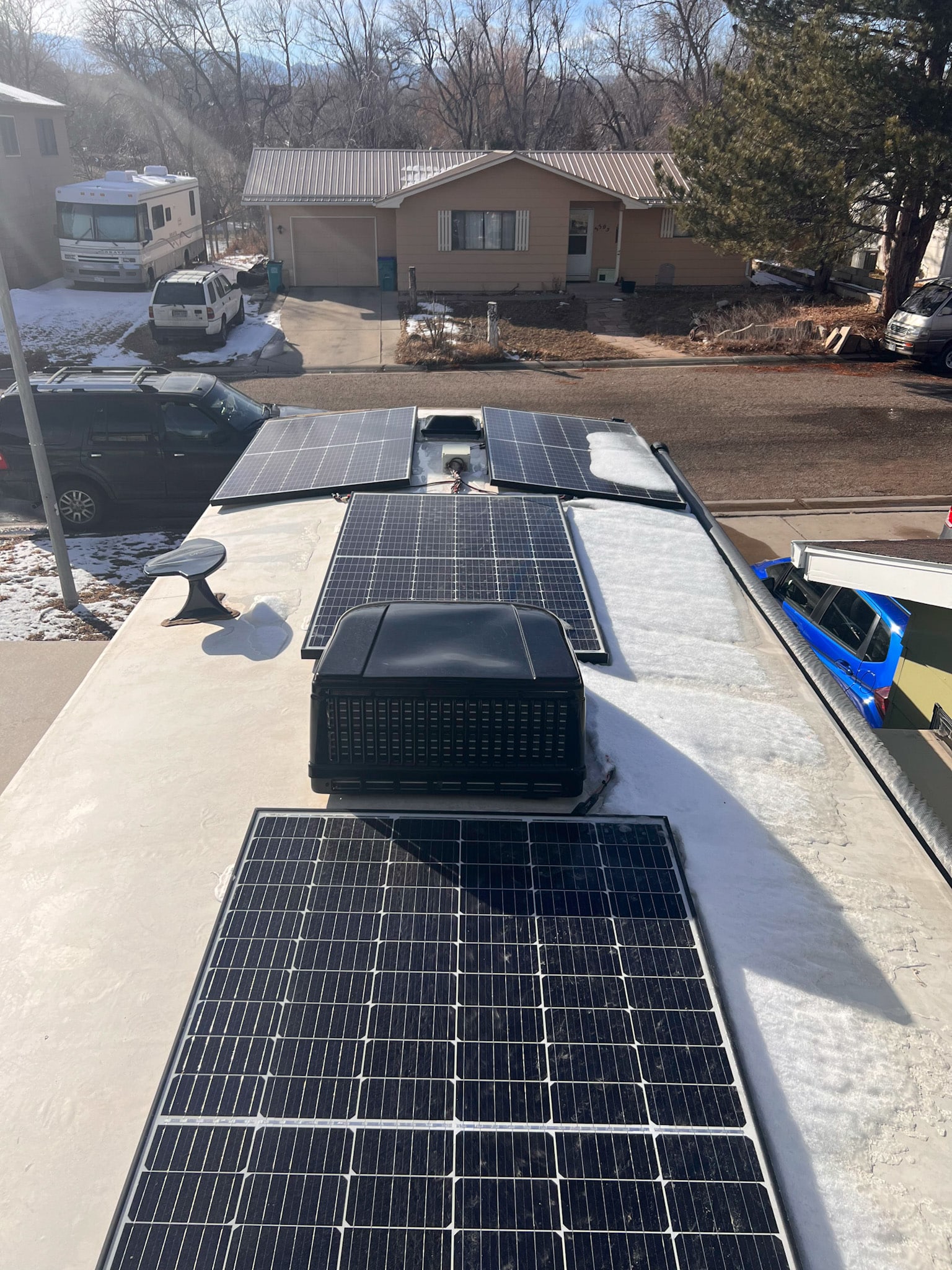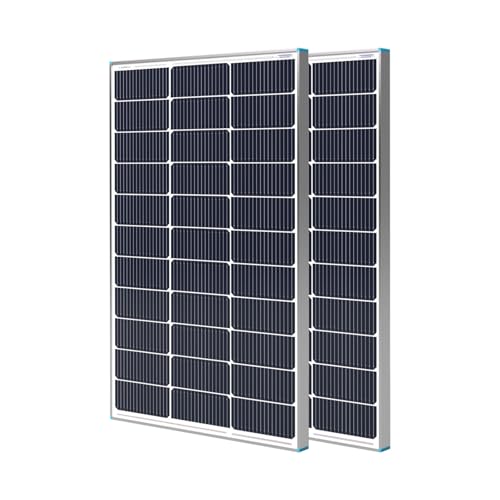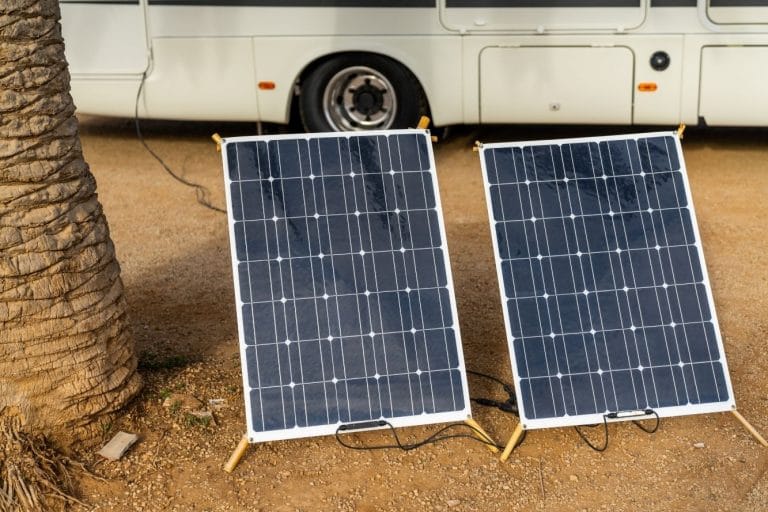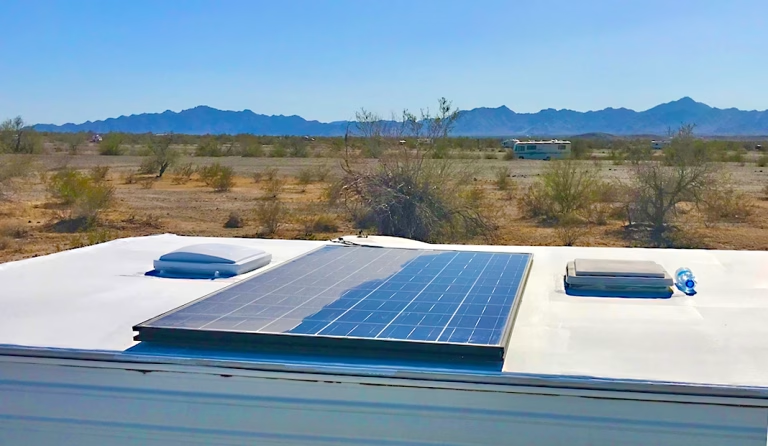Comparison Guide: What Type of Solar Panel is Best for RV Boondocking?
This post may contain affiliate links.
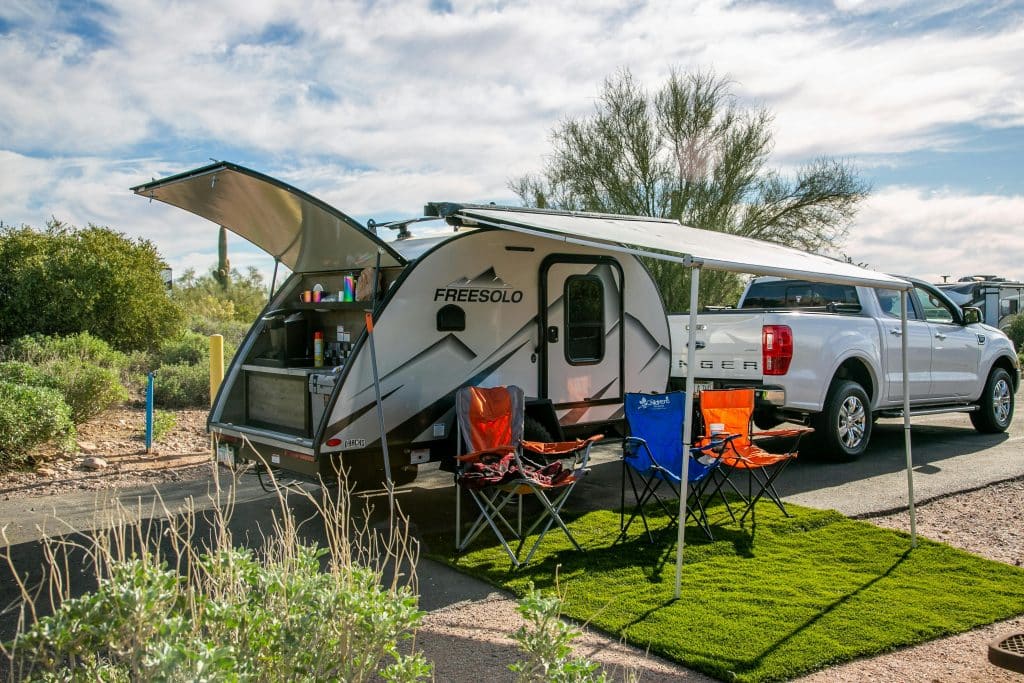
When it comes figuring out the best type of solar panel for RV boondocking, there’s a big decision to make: Should you go with portable panels or roof-mounted ones? Rigid or flexible? Or some combination for a hybrid approach? Each option has its pros and cons, and the right choice depends on your travel style, energy needs, and budget. This article will compare portable vs. fixed RV solar panels so you can figure out which one makes sense for you!
If you’re new to researching solar power, be sure to also check out our guide RV Solar Power Basics: 5 Things You Need to Know.
Types of Solar Panels for RV Owners to Choose From
One of the first choices you’ll need to make in putting your RV solar system together is which kind of solar panels you’ll want to use.
First of all, you’re looking for monocrystalline solar panels. (You don’t want the older polycrystalline type, such as those you might find at Harbor Freight – they’re inefficient and their cost-per-watt is ridiculous.) There are three main types of monocrystalline solar panels:
Rigid/Residential Style
Rigid solar panels are the kind you see on house roofs, in large field-mounted arrays, and on equipment in remote locations, such as the ones mounted on poles outside of the front gatehouses of Long Term Visitor Areas (LTVAs) in places such as Quartzsite, Arizona. They’re also the ones I’ve used on my longer travel trailers since my second one, and will likely continue using because they’ve served me very well without pause. The only maintenance they’ve required is an occasional cleaning, and that’s true of any solar panels.
- 𝗠𝗮𝗿𝗸𝗲𝘁-𝗟𝗲𝗮𝗱𝗶𝗻𝗴 𝟮𝟱% 𝗖𝗼𝗻𝘃𝗲𝗿𝘀𝗶𝗼𝗻 𝗘𝗳𝗳𝗶𝗰𝗶𝗲𝗻𝗰𝘆 – Renogy’s 100w solar panel features A+ grade n-type solar cells, achieving an impressive 25% conversion efficiency. This slolar panel delivers 20W more power output compared to standard solar panels 100 watt of the same design, making it an excellent choice for solar energy solutions.
Pros:
The biggest advantage of rigid style panels is that you can buy them used for roughly 25 cents per watt, many still carrying 10-20 year warranties. That warranty usually won’t transfer to you, but it’s nice to have confidence that they were built to last that long. They are very reliable and sturdily built to withstand all but the largest hailstones. These ship with industry standard MC4 connectors. You can find used ones on Facebook Marketplace and Craigslist.
Cons:
You trade significant weight (55-70 lbs each) and roof real estate (they tend to measure somewhere around 40 x 60 inches, but can be as long as 80 inches and as narrow as 36 inches) for this durability. You also need to screw or bolt them onto your roof, which means putting holes in it. That freaks a lot of folks out, but I’ve done it three times, and if you take your time and do it right, you really don’t have to worry about leaks. Mine never leaked, but I also went up on the roof for a close inspection at the end of every winter season. Limited to 500w, but it’s hard to find any over about 415w.
Flexible style
Flexible solar panels are just what they sound like: built of flexible plastic that can conform to curved surfaces.
- 【High Power Output】 Renogy 200w flexible solar panel can provide an average of 1000 Watt-hours of electricity per day (caculates with 5 hours sunlight).
Pros:
They tend to be smaller and far more lightweight than residential style, and generally ship with standard MC4 connectors. You can choose to mount them or leave them loose to move around with the sun (I did the former on my first rig, and the latter on my second). You can mount them directly to your RV’s roof without brackets, so you don’t have to put holes in your roof. I’ve seen others mount them with heavy duty double-sided acrylic tape over RV windows like shutters, so they work on the move. When they get to their campsite, they raise them like mini-awnings over each window so they face the sky and produce more efficient energy.
Cons:
Oddly, they cost more than rigid – about $1.00/watt – and are generally limited to 200-300 watts per panel. They’re also not as durable, especially in big hail. If you do decide to mount them, and use an adhesive for a direct-to-roof mount, the panels can overheat and burn out. Brian at Travels with Tito came up with a brilliant alternative that not only avoids that problem, but also makes the panel easily removable to swap out with a new one. However, his update a year later made it clear that not using the Loctite would be a better idea.
Portable Style
Portable solar panels are the ones that generally come with portable power stations, but there are plenty of standalone models.
- Powerful yet Compact: Boasting a 1,500W AC output and a 3,000W surge peak, the Solar Generator 1000 V2 can power multiple appliances, including AC units, fridges, and electric pots. With a 1,070Wh capacity and a lightweight build of only 23.8 lbs, along with a foldable handle, it makes an excellent companion for outdoor camping, road trips, and emergencies.
Pros:
Most of them fold up and are pretty easy to stash away, unless you have a tiny camper, in which case you can generally find a place to put them in your tow vehicle or on a cargo rack. If you get them with a same-branded power station, you know the connector will match with the port on the station. Some come with a built-in rack that helps them stand up like a pyramid, reducing the chance they’ll blow over.
Cons:
Watt for watt, they are pretty expensive, at least $1.00/watt and generally more like twice that. And they’re nowhere near as durable as the rigid or even flexible styles. It doesn’t even take big hail to destroy them, and even letting them get wet in a rainstorm can ruin them. The active cell face itself tends to be of a softer material and seems to collect dust faster, so you need to clean these often; sometimes daily in windy conditions.
Speaking of wind, these blow over quickly in anything above about 10mph, so you’ll need to rig up some kind of stand or lash them to something sturdy, which can be difficult when you have to keep moving them around to follow the sun. So you just have to be okay with a little more babysitting and making sure to bring them in if things look stormy. If you’re not using them with a power station and want to plug them directly into your RV-mounted system, you may need to change the plug it ships with to a standard MC4 connector or even a Zamp Solar SAE Y connector, depending on your rig. Limited to 600 watts each.
Comparing Portable vs. Fixed RV Solar Panels: 5 Questions to Ask
1. How Easy Are They to Set Up?

Portable Solar Panels
Portable panels are perhaps the simplest because they are plug-and-play essentially! They’re super easy to set up; you just unfold them, point them toward the sun, and connect them to your RV’s battery. No tools, no hassle! They’re perfect if you want simplicity or don’t have a way to do roof-mounted panels.
Roof-Mounted Solar Panels
Roof-mounted panels are a little bit of a different story! Many manufacturers offer solar panels on brand new RVs but if that’s not your situation then you have to install them. That can involve drilling, wiring, and sealing. You can DIY if you’re confident with it, but many people hire a professional to make sure everything’s done right. It’s more work upfront, but once they’re installed, you don’t have to think about getting them out everyday.
Bottom Line: If you want something quick and easy, portable panels are the way to go. If you’re okay with a bit more work for a long-term solution, roof-mounted panels are worth it.
2. Which One’s More Flexible?
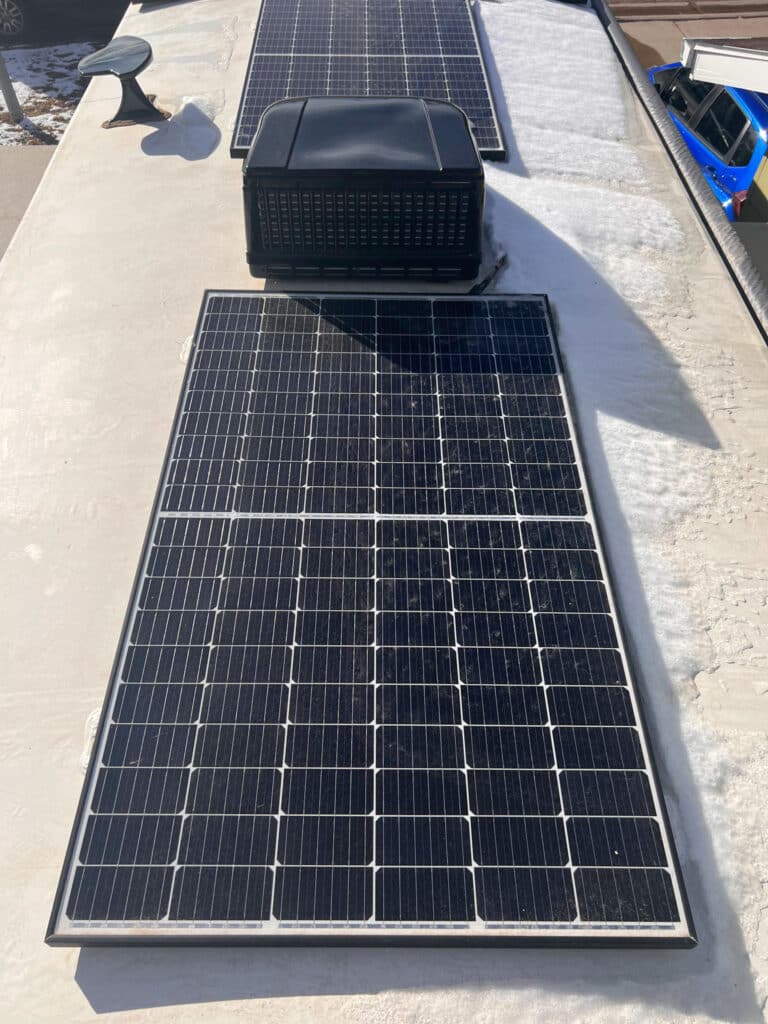
Portable RV Solar Panels
Flexibility is where portable panels shine! You can move them around to follow the sun, which is great if you’re parked under trees or in a shady spot. They’re also easy to pack up and take with you if you’re switching campsites. However, because they aren’t mounted and can be quite large, remember that when you’re traveling you need the space to safely store them. You also need a campsite large enough to put them out.
Roof-Mounted Solar Panels
Roof-mounted panels are fixed in place, which has its perks. They work no matter where your RV is parked – even when you’re driving – and you don’t have to worry about setting them up every day. But, if your RV is parked in the shade, they won’t be able to catch as much sun as portable panels. Just like portable ones, you will need to clean them from time to time to ensure ultimate energy absorption.
Bottom Line: Portable panels win if you’re all about flexibility and chasing the sun. Roof-mounted panels are better if you prefer a set-it-and-forget-it approach.
3. How Much Energy Do They Produce?

Portable Solar Panels
Portable panels are great for smaller energy needs, like charging phones, running lights, or powering a fan. This can be great if you have a small rig or just camp temporarily. But if you’re in a large RV and trying to run appliances like a fridge or A/C, then portable solar panels may not cut it for you.
Roof-Mounted Solar Panels
Roof-mounted panels typically have more capacity and can produce a lot more energy, making them ideal for full-time RVers or anyone with a lot of gadgets and appliances to power. The biggest advantage here is that they are always out, so naturally they may collect more energy. You can also cover your roof in them, and having that many solar panels on the ground would be challenging.
Bottom Line: If you’ve got a smaller rig or light energy needs, portable panels are a solid choice. Bigger setups or full-time travelers will get more out of roof-mounted panels.

4. What do they cost?
Portable Solar Panels
Portable panels are easier on your wallet upfront. You can find a decent setup for a few hundred bucks, which is great if you’re just getting started with solar or not sure how often you’ll be using it.
Roof-Mounted Solar Panels
Roof-mounted panels are a bigger investment, just like solar panels would be on a house. Between the panels themselves and the installation, the upfront cost is higher. But they’re built to last and can save you money in the long run, especially if you’re a frequent traveler. Or spending winters in the desert!
Bottom Line: Portable panels are budget-friendly to start, but roof-mounted panels could save you more over time if you’re using them a lot. This is really a personal decision based on your needs!
5. Are They Durable and Easy to Maintain?
Portable Solar Panels
Since you’re moving them around, portable panels are more prone to wear and tear. You’ll need to be careful when setting them up, packing them away, or storing them. The upside? They’re easy to clean since you can just wipe them down when they’re folded up. Or if there is a storm coming, you can pack them away – many are very lightweight these days, like these!
Roof-Mounted Solar Panels
Roof-mounted panels are built tough to handle all kinds of weather – rain, wind, snow, you name it. Once they’re up there, you don’t have to worry about them getting bumped around – unless you drive under trees with low limbs! Cleaning them can be trickier since you’ll need to get up on the roof, but they’re less likely to get damaged. Check out Rich Solar’s affordable kits!
Bottom Line: Portable panels are easier to clean but need gentler handling and a place to store them when not in use. Roof-mounted panels are sturdier but require some effort to maintain.

Another Option: Go with a Hybrid Approach
You don’t actually have to choose between portable vs. fixed RV solar panels. Many off-grid campers choose both! This gives you the most flexibility and even more power than going with just one option by itself. Of course, it also costs more, so if money is limited you might want to start with one option and add to your RV solar setup over time.
Conculsion: What type of solar panel is best for RV owners
Choosing the best type of solar panel for RV camping off grid really comes down to how you travel and what your energy needs are. Portable panels are great if you’re all about flexibility and keeping things simple, while roof-mounted panels are better for long-term use and high energy demands.
Think about how often you’ll use them, your budget, and whether you want the convenience of a permanent setup or the flexibility of moving your panels around. Either way, you’re taking a great step toward more sustainable and independent RVing!
Your next step: Figure out how many solar panels you’ll need
After you’ve decided what type of solar panel is best for RV boondocking, the next step is to figure out how many solar panels you need to buy! To determine this, read this article next: How Much Solar Do I Need for My RV? 5 Steps to Know for Sure.
Ashley Mann founded RVinspiration.com in 2017. She handed off the website to new owners in 2022 to launch a new business as an online entrepreneur coach, but she still helps out as the blog editor. Ashley spent three years living full time in a 38-foot, 5th-wheel RV with her husband Josiah and their cat, Kitty. Her favorite thing about RV life is the challenge of finding the perfect way to organize a space, and she loves seeing all the creative and clever ways people come up with to customize their RVs.

